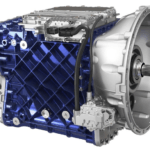The Volvo VN 630 is a regional long-haul truck that is manufactured by Volvo Trucks. It is also referred to as the VNL64T630. This Volvo VNL 630 review will cover the tractor’s aerodynamics, maintenance, transmission, engine, driver comfort, and problems associated with particular model years.
Aerodynamics
The Volvo Vnl 630 is generally equipped with a mid-roof configuration with an occasional one being a high roof tractor. Trucks fully equipped with the roof and side fairings have been found to increase fuel efficiency by approximately 10%. The Volvo VN 630 is designed for regional long-haul operations which may involve bulk and specialty loads. The aerodynamics are standard with the exception of a high roof fairing which is possibly why this truck is promoted to flat bed and tanker operators. The Volvo VN 630 is listed as a designated SmartWay tractor by the EPA as long as the model is newer than 2007. The overlapping sun visors serve a dual-purpose by deflecting sunlight from the driver’s line of vision and forcing air pressure up over the truck’s hood.
Suspension and Wheelbase
Suspension air bags are mounted outside the frame. Vertical and lateral shock absorbers soften road bumps and reduce rocking and swaying, something much needed in a model with a shorter wheelbase than many other available over-the-road tractors. The wheelbase found in existing tractors will generally be about 215-220. 230-240 is the norm for most semi-tractors. The premise behind a longer wheelbase is that it makes for a smoother and more stable drive, especially for long-haul trucks that drive at highway speeds for prolonged durations. The axle config is a 6×4 tandem.
The base model boasts a single bunk but a double-bunk configuration is available. A lot of consideration and work have been put into the cab design to improve driver comfort. The steering wheel is resistant to road vibration. Quality insulation and soundproofing help to keep the cab quiet to improve driver concentration. There are many other amenities included in the cabin of the Volvo VNL 630 such as generous storage space, temperature control panels, and sleeper curtains.
Engine
The Volvo D13 is the standard configuration as far as engine selection is concerned. The more powerful D16 engine is available for larger and heavier load applications. It is hard to say if the D13 engine configuration would suffice as anything other than day cab utilization given that the highest of the 6 variations is 500HP. On the other hand, the lowest power variation with the D16 starts at 500 horsepower with peak torque of 1850 lbs.-ft.
There have been numerous reports of D16 engine problems with the exhaust gas re-circulation (EGR) system for pre-2010 trucks post the 2007 EPA Regulations. It’s always a safe bet to not be the first to trail a truck with new technology that is built on the basis of government regulations because it enforces restrictions for the manufacturer that otherwise wouldn’t be there. the first. The D16 does have a higher rate of fuel consumption which is why opting for trucks equipped with ECO-Torque is a wise choice.
There have been numerous reports of D16 engine problems with the exhaust gas recirculation (EGR) system for pre-2010 trucks post the 2007 EPA Regulations. It’s always a safe bet to not be the first to trial a truck with new technology that is built on the basis of government regulations because it enforces restrictions for the manufacturer that otherwise wouldn’t be there. The D16 does have a higher rate of fuel consumption which is why opting for trucks equipped with ECO-Torque option is a wise choice.
As far as the overall market is of concern, the post-2014 Volvo D16 engines have good reliability with the EGR and related emissions technology problems seem to have been sorted out.
The tank capacity differs but is generally in the 250-gallon range with the larger 150-gallon tank on the driver’s side. This is adequate capacity for a single fuel-up for most regional round trips.
Volvo D16 engines are no longer in active production as of 2017 but maintenance services are still available.
12 Speed I-Shift Transmission
Most Volvo VN 630’s you’ll find on the aftermarket will have an automated manual transmission. Volvo’s 12-speed I-shift transmission have shown good reliability in the automated manual transmission segment.
One of the disadvantages of the older model VN 630’s is that they don’t have the new I-See technology. It’s a system that learns the terrain and topography of the road and shifts gears accordingly. It’s still early to say, but this technology does seem to address a number of the problems drivers have experienced with automatic transmissions and likely the reason why many of them opt for the traditional manual stick.
Overall, the price will be a final determining factor but this Volvo VNL 630 review determines it is a suitable choice for regional-haul operations with medium-to-heavy duty loads.
If you would like to see more reviews similar to this one, please let us know through the website’s contact page.



